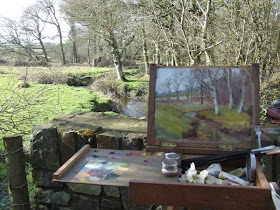 |
| Sarah Biffen Engraving of self portrait |
Sarah Biffen was a Victorian Artist who Dickens included amongst the characters in Nicholas Nickleby, Little Dorrit and Martian Chuzzlewit. Sarah was born in the Somerset village of East Quantoxhead in 1784. She was a remarkable person who overcame enormous obstacles to become an artist. She was born without arms and only vestigial legs, so as an adult she was only 37 inches tall!
By the age of twelve she had learnt to read and use her mouth to hold a pen to write. She had also learnt to embroider using her teeth to work the needle.
By the age of 15 she was part of a traveling fair and it is said that the owner of the sideshow in which she appeared Emmanuel Dukes taught her to paint. This was to enhance her as an attraction that people would pay to see at work.
 |
| 1812 Broadside |
Sarah later in her life insisted that she had been treated with kindness by the Dukes and certainly they provided her with a means of making her own living. During St. Bartholomew’s Fair in 1808, the Earl of Morton came to see the painting ‘Limbless Wonder’ and was genuinely surprised by how talented the girl was.
 |
| Sarah Biffen miniature self portrait |
The Earl was so impressed that he sponsored Sarah and paid for lessons from Royal Academy painter, William Craig. With support from the Earl Sarah became a painter of miniature portraits with a studio in London. During this time she was awarded a medal from the Royal Society of Arts and five of her paintings were accepted by the Royal Academy.
 |
| Portrait of a Lady |
The Royal Family commissioned a series of miniatures from her including one of Edward, Duke of Kent, painted by Sarah in 1839 and purchased by the Duke's daughter, Queen Victoria. It is now part of the Royal Collection.
 |
| Miniature Watercolour on Ivory |
Queen Victoria awarded her a Civil List pension and she retired to Liverpool were she continued to paint, this is a portrait of James West captain of the “Atlantic” which carried mail between New York and Liverpool.
 |
| Captain James West 1844 |
Sarah Biffen died October 2, 1850 at the age of 66. She is buried in St James Cemetery in Liverpool.







































